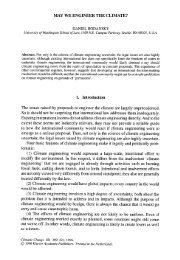ThorEA - Towards an Alternative Nuclear Future.pdf
ThorEA - Towards an Alternative Nuclear Future.pdf
ThorEA - Towards an Alternative Nuclear Future.pdf
You also want an ePaper? Increase the reach of your titles
YUMPU automatically turns print PDFs into web optimized ePapers that Google loves.
Chapter 2: Thorium-fuelled ADSR technology in a UK context<br />
2.1 ADSR technology <strong>an</strong>d UK carbon<br />
emission commitments<br />
The Government introduced legally-binding targets for<br />
CO2 emissions reductions in the 2008 Climate Ch<strong>an</strong>ge Act.<br />
The long-term target is <strong>an</strong> 80% cut from 1990 levels; <strong>an</strong><br />
intermediate target of 34% by 2020 has also been set (HM-<br />
Government, 2009), with the EU also setting a 2020 target for<br />
the UK to generate 15% of its energy for heat, electricity <strong>an</strong>d<br />
tr<strong>an</strong>sport from renewables. (Europe<strong>an</strong> Commission, 2008).<br />
It is widely believed that CO2 reduction targets will be very<br />
difficult to meet (Cambridge-Econometrics, 2009) without<br />
signific<strong>an</strong>t investment in new nuclear pl<strong>an</strong>ts.<br />
The combination of binding targets, limited alternatives<br />
<strong>an</strong>d a political desire to show leadership (Europe<strong>an</strong> Union,<br />
2008) should me<strong>an</strong> that nuclear power generation features<br />
prominently in the energy pl<strong>an</strong>s of future UK Governments<br />
<strong>an</strong>d EU administrations.<br />
The carbon reduction potential of nuclear power is enormous.<br />
All power generation technologies face construction emissions,<br />
but once nuclear generators are operational the direct carbon<br />
emissions are effectively zero. As nuclear is ‘base load’ power it is<br />
<strong>an</strong> obvious replacement for carbon-intensive coal <strong>an</strong>d gas which<br />
have fluctuated in price considerably in recent years.<br />
<strong>Nuclear</strong> power also has the potential to de-carbonise heating<br />
<strong>an</strong>d tr<strong>an</strong>sport. To achieve this, low carbon power is required<br />
on a very large scale. <strong>Nuclear</strong> power is the only indigenous<br />
low-carbon power source available to the UK which has the<br />
potential to scale up sufficiently to meet the legally binding<br />
emissions reductions targets that have been set.<br />
Price per tonne of CO2 £12 £/tonne CO2-equivalent<br />
Yearly energy produced 7.45 TWh/yr/GWe@85%avail<br />
Steam cycle efficiency 33%<br />
Energy from combustion 81.2 HexaJ/yr/GWe@85%avail<br />
CO2 emissions from coal 1030 kg CO2/MWhe<br />
CO2 emissions from nuclear 10 kg CO2/MWhe<br />
Emission saved per reactor unit 7.6E+06 tonnes of CO2/yr/GWe<br />
Fin<strong>an</strong>cial value of emissions reduced £76,000,000 £/yr/GWe<br />
18 <strong>Towards</strong> <strong>an</strong> <strong>Alternative</strong> <strong>Nuclear</strong> <strong>Future</strong><br />
There are also wider opportunities for global carbon<br />
reduction. A key feature of the proposed thorium-fuelled<br />
power station design is its suitability for export. There is<br />
growing international interest in nuclear power with growth<br />
projected to be between 27% <strong>an</strong>d 100% over current capacity<br />
by 2030 (IAEA, Intern ational Status <strong>an</strong>d Prospects of <strong>Nuclear</strong><br />
Power, 2009). Potential international customers might also<br />
envisage thorium-fuelled ADSR applications beyond just<br />
electricity generation, for example in seawater desalination,<br />
high temperature chemical processing <strong>an</strong>d industrial or<br />
district heat.<br />
2.2 Fin<strong>an</strong>cial Value of Carbon Emission Reduction<br />
If nuclear power is finally considered as the leading CO2<br />
emissions reduction technology (of which ADSR technology<br />
could be a signific<strong>an</strong>t component) there is a subst<strong>an</strong>tial<br />
source of revenues available from trading credits in carbon<br />
markets, such as the Europe<strong>an</strong> Trading Scheme. A first<br />
estimate of these profits yields that by migrating from coalfuelled<br />
pl<strong>an</strong>ts to ADSRs yearly returns could reach £76 million<br />
per year per GWe, as presented in the Table below. Even if only<br />
a fraction of these benefits were gr<strong>an</strong>ted, it would further<br />
enh<strong>an</strong>ce the economic appeal of ADSRs.<br />
All three main UK political parties recognise the need to decarbonise<br />
energy sources; only the Liberal Democrats oppose<br />
nuclear power. It is pertinent to ask whether thorium-fuelled<br />
ADSRs, with their low waste, sub-criticality <strong>an</strong>d proliferation<br />
resist<strong>an</strong>ce could redress the bal<strong>an</strong>ce in favour of a nuclear low<br />
carbon option amongst the traditional <strong>an</strong>ti-nuclear lobby.



